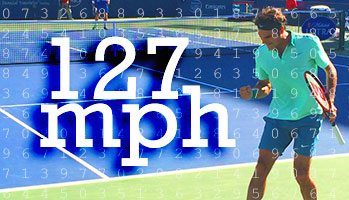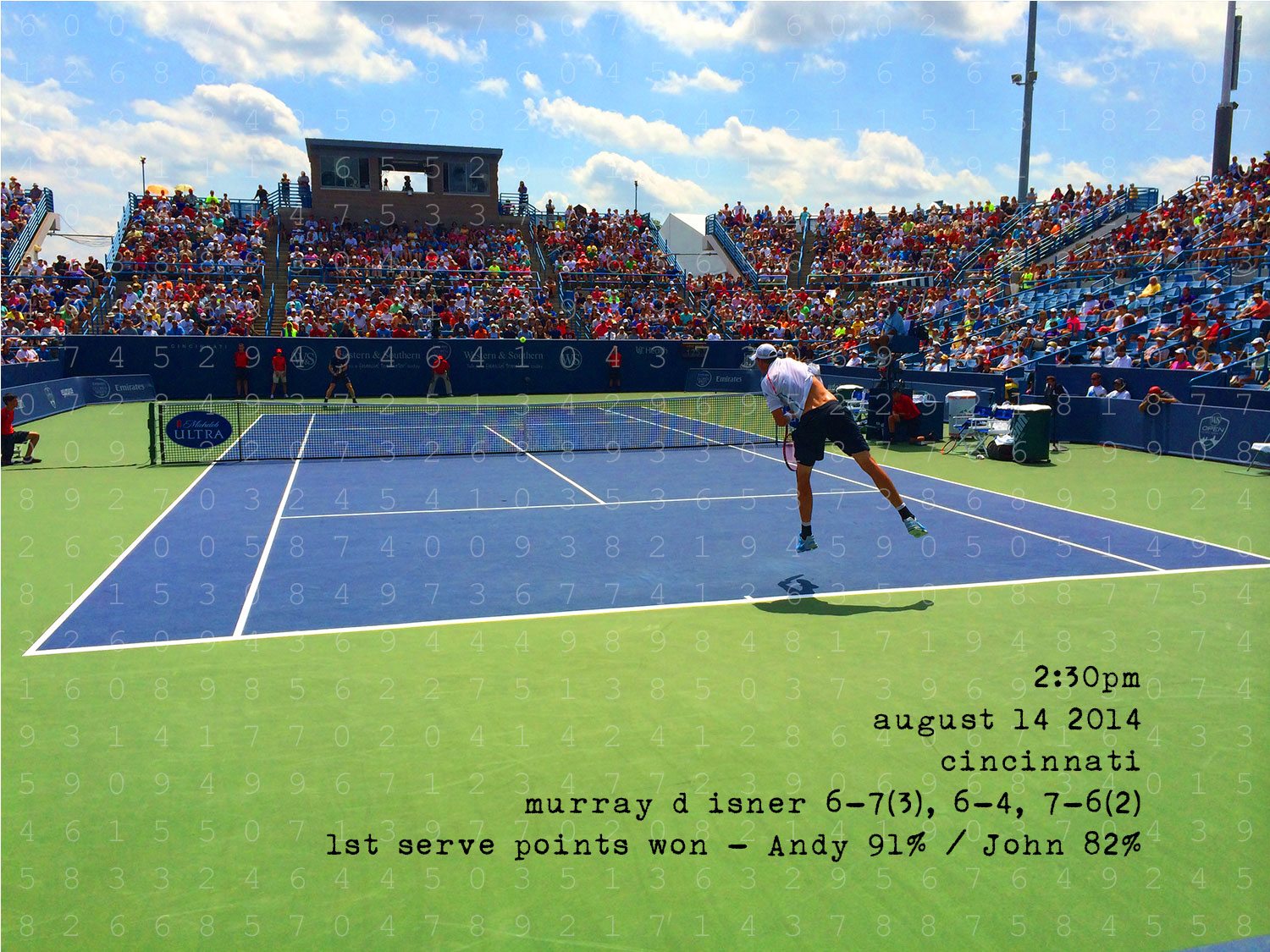Serve Speed Matters

2012 U.S. Open Men
Fastest 15 serve speeds combined won 36 matches
Slowest 15 serve speeds combined to win 3 matches
Is there a relationship between serve speed and winning tennis matches?
Oh, Yes.
Whenever we start to look at serve speed, the typical progression then goes to ace totals. That’s not really where we should be looking. I have never really seen information that directly relates the power of the serve to the winning percentage of matches.
So here it is – and, particularly for men’s tennis, it’s shocking.
2012 U.S. Open – MEN
It does not matter if you have the fastest serve in the world, but it does matter that you can hit it with authority.
Put another way, you absolutely MUST have a strong 1st serve – one that is able to occasionally hit aces and service winners. But that’s not the real measurement and ultimate purpose of a first serve. The majority of serves in tennis come back into play and the quality of the first serve must be able to elicit a weak return from the opponent that can be lent on to gain immediately gain control of the point.
Hitting your spots serving is a big deal, but there is no denying the raw facts that the ability to put some pop on the serve is a huge, huge indicator of wins and losses.
This is about as black and white as you can get.
MEN – Top 30 Serve Speeds
(94 of the 128 players played on a court where serve speed was recorded).
The top 30 serve speeds varied from 144mph to 132mph (231.7kph to 212.4kph).
That’s a difference of 12 mph (19.3kph). John Isner hit the fastest and Novak Djokovic, James Blake Mardy Fish, James Blake, Ryan Harrison and Philipp Petzschner rounded out the Top 30 at 132mph.
The bottom 30 serve speeds varied from 126mph (202,7kph) to 106mph (170kph) – a much bigger difference of 20mph (kph)
Here’s where things get very interesting.
The top 30 serve speeds combined to win a whopping 63 matches with only Benjamin Becker, Kevin Anderson and Jesse Levine failing to win a match. That’s unbelievably impressive numbers that create no confusion in this area at all – if you can pop a serve, you can get control of the point, and ultimately be very successful winning tennis matches.
Now let’s have a look at the bottom 30 serve speeds. They only combined to win 25 matches, which is less than 40% of the success the Top 30 serve speeds experienced. While the Top 30 only had three players who failed to win a match, the bottom 30 had 17 players who did not reach the second round.
| Players MEN | Combined Matches Won | Lost In 1st Round |
|---|---|---|
| Fastest 30 Serve Speeds | 63 | 3 |
| Slowest 30 Serve Speeds | 25 | 17 |
The Top 15 serve speeds also help to tell a clearer story. Only one of the Top 15 serve speeds lost in the opening round, while 12 of the bottom 15 all lost in the opening round. The Top 15 serve speeds combined to win 36 matches, while the bottom 15 serve speeds won three matches.
Ouch.
You don’t really need to dig much further to see the writing on the wall here. Serve speed MATTERS!
| Players MEN | Combined Matches Won | Lost In 1st Round |
|---|---|---|
| Fastest 15 Serve Speeds | 36 | 1 |
| Slowest 15 Serve Speeds | 3 | 12 |
At the 2012 U.S. Open, the dividing line was clearly set right at 127mph (204.3kph).
Both Roger Federer and Janko Tipsarevic topped out at this speed, and both made the quarterfinals. All the other quarter finalists, except David Ferrer, were higher than them in serve speed.
Below 127mph was more like a wasteland.
Only two players who had a top speed of less than 127mph reached the 4th round (Ferrer and Martin Klizan). There were 63 players who could hit at a minimum of 127mph. Of the 31 who failed to reach that speed, 17 lost in the opening round and another seven dropped off in the second round.
Clearly, 127mph was the dividing line between having a genuine shot at the title, and not. Remember, there will always be exceptions, and David Ferrer is the poster child in this particular area. What he lacks for in serve speed, he doubles up with hustle, speed, footwork, grit and guts in other areas. He has found a way to adapt and cover up this weakness that the others simply have not.
Serve Speed Men v Women
The number one difference between men’s tennis and women’s is the power of the serve. I wrote an article in the New York Times as a preview to the 2013 U.S. Open that focused exactly on this aspect of the game, and that difference has a snowball effect on all strategy aspects that follow it.
2012 Fastest Serves.
John Isner 144mph
Serena Williams 125mph
At the 2012 U.S. Open, 69 of the 94 players who had their serve speed recorded hit a faster serve than Williams’ best at 125mph. Only five of the 82 women recorded hit a serve of at least 120mph, but only five men could not reach that speed with their fastest delivery.
The difference is considerable and makes for a very tough “apples to apples” comparison between the two tours.
Ace Leaders
Raonic hit 103 in four matches, averaging 13.5 aces/set to lead the tournament.
Williams hit 63 aces in 15 sets for an average of 4.2 per set.
2012 U.S. Open – WOMEN
On the women’s side, 82 of the 128 players had their serve speed recorded.
The speed of the serve is very different from the men, and it evens the playing field, diminishing the power effect.
6 players in the women’s draw hit a fastest serve of at least 120mph (193.1kph), while that accounted for 89 of the 94 recorded.
The data shows that serve speed is not nearly as critical in the women’s game.
The fastest 30 serve speeds won 58 matches, while the slowest 30 serve speeds won 41 matches. So for the men, the bottom 30 serve speeds won only 40% of what the Top 30 achieved, while for the women the slowest 30 won 70.6% of the fastest 30.
| Players WOMEN | Combined Matches Won | Lost In 1st Round |
|---|---|---|
| Fastest 30 Serve Speeds | 58 | 8 |
| Slowest 30 Serve Speeds | 41 | 10 |
To highlight just how much success with serve speed can vary, the fastest serve speed of 125mph (201.1kph) was hit by Serena Williams who won the event. Sara Errani came in last in the recorded matches with at 95mph (152.9kph), but reached the semi-finals. Go figure.
In the Top 30 serve speeds, 8 lost in the first round, while 10 lost in the opening round in the bottom 30. There is much more of an evenness in this area with the women than the men.
The Top 15 Serve Speeds for the women show much more a separation in total matches won. The slowest in the Top 30 won 70% of total matches as the Top 30 serve speeds, but the slowest in the Top 15 only won 48% of what the fastest 15 did.
This does mirror the men, in that there is more separation comparing the fastest and slowest 15 than 30. There is really a difference when isolating the best in the world.
| Players WOMEN | Combined Matches Won | Lost In 1st Round |
|---|---|---|
| Fastest 15 Serve Speeds | 29 | 4 |
| Slowest 15 Serve Speeds | 14 | 6 |
